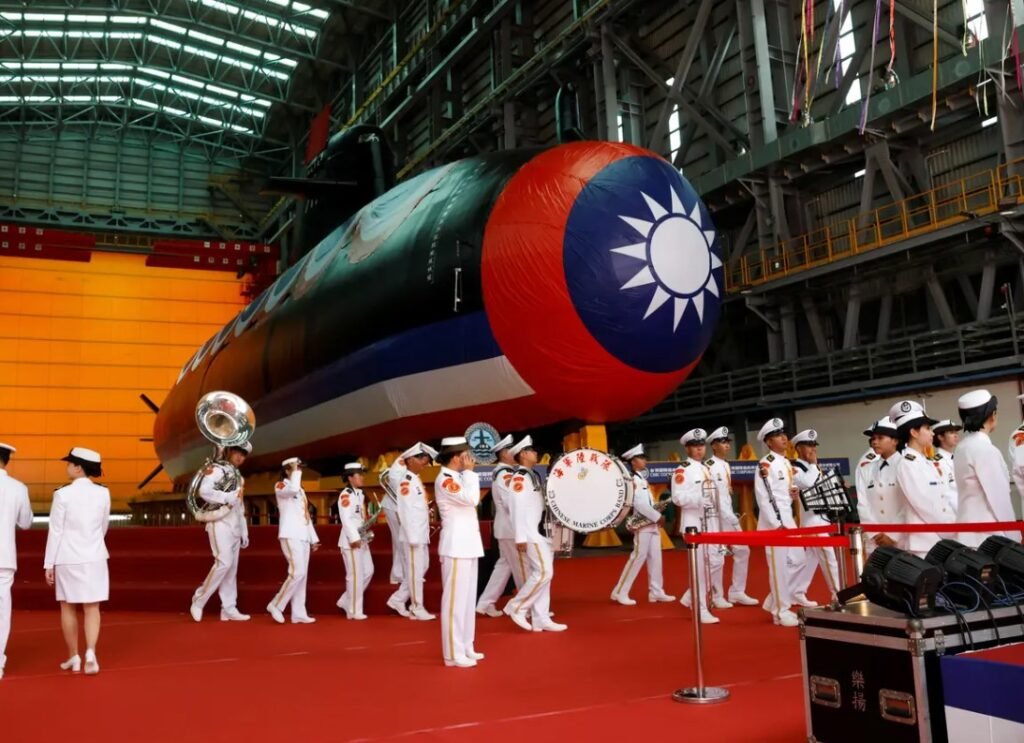Taiwan has revealed its first domestically developed submarine as part of its efforts to strengthen its defense and deterrence against the Chinese navy. The submarine, named the Narwhal, is a major milestone in Taiwan’s ambitious project to modernize its armed forces amid rising tensions with Beijing.
Narwhal: A symbol of Taiwan’s self-reliance
President Tsai Ing-wen, who initiated the plan when she took office in 2016, showcased the submarine on Thursday in the southern city of Kaohsiung. She said the Narwhal would play an important role in enhancing the navy’s “asymmetric warfare” capabilities.

“In the past, a domestically developed submarine was considered an impossible task. But, today, a submarine designed and manufactured by our country’s people sits before our eyes,” Tsai said, adding that it would allow the self-reliant national defense policy to grow and flourish on Taiwan’s land.
Taiwan’s red flag, featuring a white sun against a blue sky, was wrapped around the submarine’s bow. Tsai said the Narwhal will enter service in 2025, joining two existing submarines purchased from the Netherlands in the 1980s.
The indigenous submarine program has drawn on expertise and technology from several countries – a breakthrough for diplomatically isolated Taiwan. Cheng Wen-lon, head of Taiwan’s CSBC Corp, which led construction of the submarine, said the domestic content of the boat was about 40%. He made no explicit mention of foreign participation in his speech in Kaohsiung.
A strategic asset to counter China’s threat
Speaking to reporters in Taipei, Taiwan Foreign Minister Joseph Wu said that faced with an increased threat from China’s military “grey zone” pressure tactics close to the island with air and naval activities, Taiwan had to strengthen its defenses.
“Having a new submarine is one of those strategies. For anyone who questions Taiwan’s submarine strategy, I would be a most forceful advocate for Taiwan to acquire submarines because that’s needed to deter war from taking place,” Wu said.
Taiwan hopes to deploy at least two such domestically developed submarines by 2027, and possibly equip later models with missiles, the head of the program said this month.
The first submarine, with a price tag of T$49.36 billion ($1.53 billion), will use a combat system by Lockheed Martin Corp and carry US-made Mark 48 heavyweight torpedoes.
The United States is Taiwan’s largest arms supplier and has been providing technical assistance for the submarine project. The de facto US ambassador to Taiwan, Sandra Oudkirk, attended the ceremony in Kaohsiung.
Taiwan, which China claims as its own territory, has been facing increasing pressure from Beijing, which has stepped up its military activities near the island. China has not renounced the use of force to bring Taiwan under its control.
Taiwan’s President Tsai has vowed to defend the island’s sovereignty and democracy and has rejected Beijing’s offer of “one country, two systems” model that applies to Hong Kong and Macau.
A milestone for Taiwan’s naval industry
The Narwhal is also a significant achievement for Taiwan’s naval industry, which has been striving to develop its own capabilities and reduce its reliance on foreign suppliers.
The submarine is named after a whale with a long tusk that lives in the Arctic Ocean. It is 68 meters long and 9 meters wide and can carry 40 crew members. It has a maximum speed of 20 knots (37 km/h) and can dive up to 300 meters.
The submarine is designed to operate in shallow waters and conduct stealth missions such as surveillance, reconnaissance, anti-submarine warfare and mine-laying.
The Narwhal is expected to undergo sea trials next year before being commissioned into service in 2025. It will be followed by seven more submarines of the same class that will be built by CSBC Corp in collaboration with other domestic companies and foreign partners.
Taiwan’s navy currently operates four submarines, two of which were acquired from the United States in 1973 and are only used for training purposes. The other two were bought from the Netherlands in 1987 and are still operational.
Taiwan has been seeking to buy new submarines from abroad for decades, but has faced difficulties due to China’s opposition and diplomatic pressure. In 2001, then-US President George W. Bush approved a deal to sell eight diesel-electric submarines to Taiwan, but the deal never materialized due to technical and political hurdles.
In 2016, Tsai decided to launch a domestic submarine program as part of her broader plan to boost Taiwan’s defense industry and self-reliance. She said the program would create thousands of jobs and stimulate economic growth.
The program has received support from several countries that have submarine expertise, such as Japan, Germany, France and Sweden. However, none of them have officially acknowledged their involvement due to China’s sensitivities.
The United States has been the most vocal supporter of Taiwan’s submarine program and has approved several arms sales to the island, including torpedoes, missiles, radars and other equipment that could be used for the submarines.
The US has also sent naval experts to Taiwan to provide technical assistance and training for the submarine project. In 2018, the US and Taiwan held a groundbreaking ceremony for a new submarine facility in Kaohsiung, where the Narwhal was built.
The US has said that its support for Taiwan’s submarine program is consistent with its obligations under the Taiwan Relations Act, which requires Washington to provide Taipei with defensive weapons and services.
The US has also said that its support for Taiwan’s submarine program is part of its broader strategy to maintain a free and open Indo-Pacific region and counter China’s growing assertiveness and coercion in the area.
